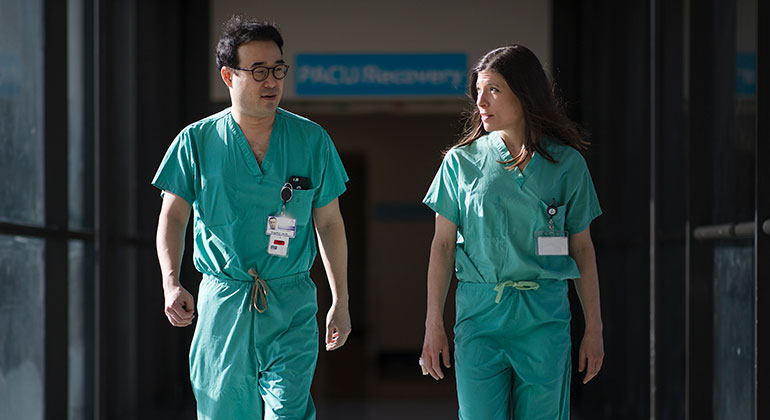Benign Esophageal Diseases

Your esophagus is a tube that connects your throat to your stomach. At Mount Sinai, our surgeons are experts in diagnosing and treating benign esophageal diseases. We work with you to determine the best approach for you medically and for your quality of life. The conditions we see most often are:
- Achalasia: Stops food and liquid from traveling through the esophagus to the stomach
- Acid reflux disorders/GERD: Severe heartburn, the most common benign esophageal disease
- Paraesophageal hernias: When part of the stomach moves into the chest
- Benign tumors: Non-cancerous growths; the most common is leiomyama
Since most of the esophagus lies in the chest, thoracic surgeons are often best equipped to treat these disorders. We are especially able to address complex cases. We have plenty of experience with failed previous repairs and a short esophagus.
Diagnosis
Symptoms of benign esophageal disease often include the following:
- Difficulty swallowing
- Feeling that something is stuck in your chest after eating
- Frequent burping or hiccupping
- Heartburn
- Painful swallowing
- Regurgitation of food and liquid
- Unintended weight loss
To properly diagnose your condition, we often perform studies such as:
- Swallow study: After you take an oral contrast, we take X-rays to follow the dye’s path through the esophagus into the stomach.
- Endoscopy: We use a thin camera to help us view the inside of the esophagus and stomach. This lets us see if there are any masses that may be causing these disorders. We can also take tissue samples for further study during an endoscopy.
- pH study: We insert a probe into the esophagus to measure the amount of acid there.
- Manometry: We insert a pressure probe into the esophagus to measure how your esophageal muscles are working.
Treatments We Offer
We treat benign esophageal conditions with a variety of approaches. We develop a treatment plan that is best for you. Our treatments include:
Medication
- Antacids: Neutralize stomach acid
- H2 blockers: Stimulate the stomach to produce acid
- Proton pump inhibitors: Reduce stomach acid
Minimally Invasive
- Botulinim toxin (Botox): Injecting Botox into your esophageal muscles helps them relax. This allows food to move more easily to your stomach.
- Endoscopy: Inserting a thin tube into your body lets us view to view the inside of your esophagus and stomach. Endoscopic procedures include confocal endoscopy, ablation, and endoscopic mucosal and submucosal dissection.
- Esophagus mucosal resection: Removing diseased parts of the esophagus and nearby lymph nodes.
- Laparoscopy: Inserting a fiber-optic instrument to see your organs or perform a procedure. Examples include Nissen fundoplication, partial fundoplication, and gastric bypass.
- Pneumatic dilatation: Using a special scope and balloon to expand the lower part of your esophageal valve. This makes it easier for food to go from your esophagus to your stomach.
Open Procedures
- Peroral endoscopic myotomy (POEM): We open your esophagus from the inside, leaving no visible scars.
- Heller myotomy: We make a small incision in the lower esophagus muscle to relieve pressure on the esophageal sphincter.
- Esophagectomy: We remove part of your esophagus and reconstruct it using some of another organ.